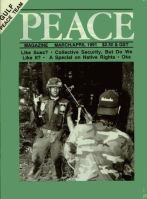
Peace Magazine Mar-Apr 1991, page 28. Some rights reserved.
Search for other articles by Dan Gaspe here
As a citizen of the Mohawk Nation, Kanesatake is my home, although I now live elsewhere. I have been involved in the native political movement all of my adult life. In early 1989 we found out that the municipality of Oka wanted to expand the local golf course onto our traditional lands. I became the head administrator for the community council of Kanesatake in January, 1990. The protection of our lands was the top community priority. Political upheaval forced me to leave my position on March 9, 1990, two days before the first occupation of The Pines occurred. I had co-chaired, the previous night, a community meeting which had decided to occupy The Pines in the face of threats from the local mayor to cancel negotiations and to proceed with the theft of our land. The community decision, following the advice of the two co-chairs, was to strictly follow a peaceful protest and defence without guns or weapons.
A minority in the community, few of whom had attended the meeting, moved quickly to occupy The Pines and to control the process. What had begun as a community exercise became a factionally-controlled campaign. The process begun in 1989, using peaceful marches and other acceptable means of protest, turned into a campaign of armed self-defence by a small group.
Self-defence is the most common argument of the supporters of the summer's crisis. Self-defence is acceptable under certain circumstances. Individuals can invoke it when there is imminent danger. It becomes an individual decision, usually based on self-preservation and on the spur of the moment. Communities or nations, on the other hand, usually have the luxury of time to layout the conditions ahead of time under which self-defence, especially involving guns and armies, is acceptable. The use of guns and para-military strategies as defensive measures have serious consequences that a community must prepare to accept before they act. In the case of Kanesatake, the decision to use guns was neither previously debated by the community nor accepted by community consensus or by the local government.
That guns were being used was known by police long before July 11. Naturally, that knowledge figured in the decision as to how much force to use, if an attack was to be launched. I do not defend police action on July 11 because other ways were available to resolve the matter, such as negotiation, siege, or other conflict resolution measures. It made no sense to provoke the police to shoot. The Sureté du Quebec (S.Q.) record with native political assertions, such as at Restigouche (1980), Les Escoumins (1988), and Barriere Lake (1989), was unnecessarily brutal, but they did not come in shooting. A blockade without guns could have provoked a riot at worse, but I doubt the S.Q. would have come in shooting.
The decision to go to war, or to use guns in a defensive action, such as Canada's decision to send ships and troops to the Persian Gulf, is so serious that it should require the prior consent of a majority of citizens and not simply a decision of government.
Canadians who want to support Mohawks in our legitimate causes are justifiably confused. Whom should you believe or support? My advice is to get the facts about the major groups and compare your personal values to those of the various factions. Most Canadians do not sanction the use of arms.
I am irked by the argument that the Warriors are heroes because they have put aboriginal concerns on the national agenda in a way that no one has ever been able to do. That is like saying Marc Lepine is a hero for having raised feminist concerns to national prominence as no feminist has been able to do. CROP and Environics opinion polls show that Quebecois are much less sympathetic to Mohawk and Native causes than before the crisis. Positive attention might have been gained by different means. Only apathy and lack of imagination limit us. Any fool can get attention by waving a gun around in public but it rarely gets him anywhere except in jail.
The situation is not good now at Kanesatake. There is much acrimony between supporters of last summer's actions and those who saw the Warriors as causing unwanted strife. The band council clings to power despite its almost non-existent power base. The Longhouse is divided. A coalition of different factions is currently united for two purposes: (a) to represent their interests in land negotiations with governments, and (b) to rid the community of the unpopular process of selecting chiefs which has plagued us since 1969. Negotiations are about to start regarding the use of the lands purchased for Kanesatake during the summer. Ironically, the lands purchased do not include the recreation area adjacent to the existing golf course. The people of Kanesatake assumed that the strip of land, where the battle took place, was purchased along with the other lands. The community needs healing but the process in place may not be adequate. The economy is in ruins and more people are on welfare than before. The effect on the children is constantly apparent and may continue for years. The Emergency Measures Team continues to operate a food and clothes bank.
I advise you not to follow any native spokesperson without regard to their past records and values. Many good Mohawks are committed to the teachings of our Great Peacemaker, who urged the use of reason and spirituality to help resolve disputes.
Dan Gaspé is the former Administrative head of Kanestake's council

Peace Magazine Mar-Apr 1991, page 28. Some rights reserved.
Search for other articles by Dan Gaspe here